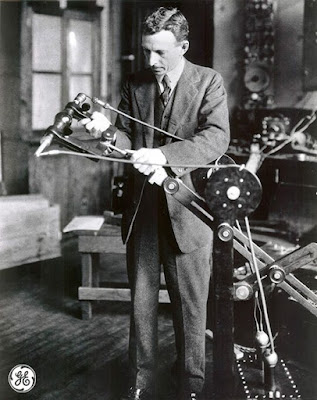Today (October 23, 1873) is the birthday of William David Coolidge, who built the first X-ray Coolidge tube using thin tungsten wire in electric lights.
William David Coolidge was born on October 23, 1873, on a farm near Hudson, Massachusetts. From 1891 to 1896 he studied electrical engineering at the Massachusetts Institute of Technology (MIT). He worked there as a laboratory assistant for two years. A year later, he went to Germany for further studies and received his doctorate from the University of Leipzig. Returning to the country from 1899 to 1905 Arthur A. of the Department of Chemistry at MIT. Was Noyes' research assistant.
Coolidge joined General Electric in 1905 as a researcher in a new research laboratory. There he conducted experiments. For the first time in fiber light bulbs he used a thin wire made of thin tungsten. By refining tungsten oxide, he created 'ductile tungsten' that could be easily pulled into fibers. Beginning in 1911, General Electric marketed lamps using new metal, which quickly became GE's main source of income. He applied for a patent for this 'invention' in 1913 (US # 1,082,933). However, in 1928 a U.S. court ruled that his 1913 patent was invalid.

In 1913 he invented the Coolidge
pipe. X-ray tube with advanced cathode for use in X-ray machines. This allowed
the deep seated anatomy and tumors to be visualized more intensely. Coolidge
pipe used tungsten fibers. The then new medical specialty was a major
development in radiology. The U.S. patent was filed in 1913 and in 1916 the
U.S. patent was granted 1,203,495. Its basic design is still in use. He also
invented the first rotating anode X-ray tube.

The Rumford Prize was awarded to Coolidge in 1914 by the American Academy of Arts and Sciences. Coolidge was awarded the American Institute of Electrical Engineers Edition Medal in 1927. In 1926 he turned down this prestigious award. He was succeeded by Howard N. in 1926. He was awarded the Potts Medal and the 1927 Louis E. Levy Medal. Coolidge was awarded the Faraday Medal in 1939. He was awarded the Franklin Medal in 1944. In 1963 the city of Remshed awarded him the Rontgen Medal for his discovery of the hot X-ray tube.
He was also selected for the
National Famous Inventor Arena. William de Coolidge, who built the X-ray
Coolidge pipe using thin tungsten wire, passed away on February 3, 1975 in New
York, USA at the age of 101. He was inducted into the National Inventors Hall
of Fame in 1975 shortly before his death at the age of 101 in Shenkot, New
York.
Source By: Wikipedia.
Information: Ramesh, Assistant
Professor of Physics, Nehru Memorial College, Puthanampatti, Trichy.






.jpg)
Very Nice Sir
ReplyDelete